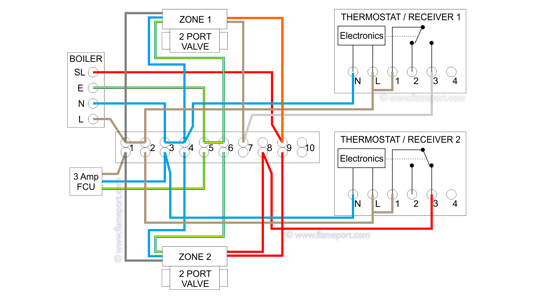Combination Boiler with Two Heating Zones - 230V
Wiring diagrams for two zone valves with a combination boiler that has 230V switching.
Overview Video
This video covers the basic plumbing arrangement for the valves, and a detailed explanation of the wiring for the valves, boiler and thermostats. View on Youtube.
Diagrams used in the video and further description continues below.
Components and Overview
Two zone valves are required, one for each heating zones. Each valve is controlled by a thermostat. This can be almost any type of thermostat, including wireless, wired, battery powered or 230V powered. Smart devices such as Hive or Nest are also possible.
A wiring centre or junction box is required to connect all of the devices together. The examples shown here use a 10 terminal wiring centre.
This arrangement is only suitable for boilers with a 230V AC switched input. Boilers with 24V or other voltages are covered separately.
Wiring
 This diagram shows the wiring for all components. This is very similar to an S-plan system.
This diagram shows the wiring for all components. This is very similar to an S-plan system.
Each zone valve is separate, and controlled by it's own thermostat.
Wiring Centre
This is just a junction box with terminals inside. This one is shown with 10 terminals.
In these diagrams, 1&2, 3&4, 5&6 have been linked together in pairs to make it easier to fit the wires into the terminals.
7 and 8 are used to connect each thermostat output to the zone valve input.
9 connects the switched outputs from the valves to the boiler input.
10 is not used in this arrangement, but if 3 zones were required, it could be used to connect the 3rd thermostat output to the 3rd zone valve.
Boiler
The boiler has a permanent 230V supply via the L,N and E wires. The boiler requires power all the time so that the hot water function will work.
The SL input is what controls the heating - connecting 230V to this terminal will activate the boiler and pump, leaving it unconnected with stop the boiler.
Zone valves
The valves have 5 wires - blue neutral, green/yellow earth. Brown is connected to the motor inside, grey and orange are connected to an internal switch.
When 230V is connected to the brown wire, the motor opens the valve and the switch inside connects grey and orange together.
Grey is connected to 230V permanently, so when the valve is powered and open, the orange wire is connected to 230V.
Thermostats
L and N provide power to the thermostat electronics. A link is added between L and 1, so that when heat is required, 230V is switched to the output on terminal 3.
The wiring shown here can be used for a 230V wired thermostat or for a wireless receiver unit. Terminal numbers are a commonly used standard backplate, including that used for the Hive wireless smart thermostat.
For a battery powered thermostat neutral is not required - only L and the switched output.
Zone 1 active
 The wires highlighted in red are connected to 230V when zone 1 is active.
The wires highlighted in red are connected to 230V when zone 1 is active.
The thermostat contact closes, which connects 230V to the output terminal 3.
This is connected in the wiring centre terminal 7 to the zone valve, the valve motor opens the valve and a switch inside connects grey and orange together.
As grey is connected to 230V, orange is also connected to 230V, terminal 9 in the wiring centre is connected to 230V and this is connected to the boiler input.
The boiler heats the water and circulates it through zone 1 only - zone 2 does not heat up because the valve for zone 2 is closed.
Zone 2 active
 The wires highlighted in red are connected to 230V when zone 2 is active.
The wires highlighted in red are connected to 230V when zone 2 is active.
The thermostat contact closes, which connects 230V to the output terminal 3.
This is connected in the wiring centre terminal 8 to the zone valve, the valve motor opens the valve and a switch inside connects grey and orange together.
As grey is connected to 230V, orange is also connected to 230V, terminal 9 in the wiring centre is connected to 230V and this is connected to the boiler input.
The boiler heats the water and circulates it through zone 2 only - zone 1 does not heat up because the valve for zone 1 is closed.
Both zones active
This is a combination of the two diagrams above. Both thermostats are active, which powers both zone valves.
Both valves open, and the switch in both valves connects orange to 230V.
The boiler is activated and hot water is circulated through both zones, as both valves are open.



